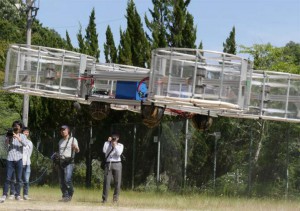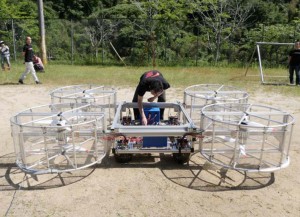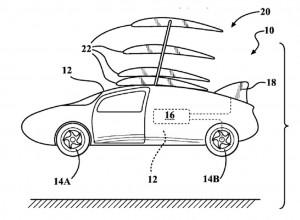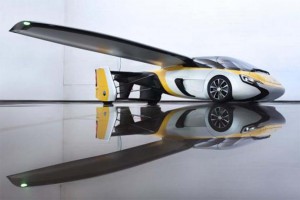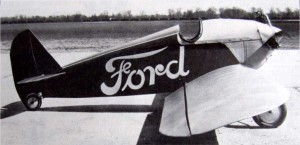Already the world’s largest automotive manufacturer, Toyota might soon dominate personal transportation on the ground – and in the air.
The industry giant is lending its support to a small Japanese tech firm, Cartivator Resource Management, that is developing a single-seat flying car it hopes to have ready to demonstrate in time for the opening ceremonies at the 2020 Tokyo Olympic and Paralympic Games, a company spokesman confirmed. Longer-term, Toyota itself is looking at what it describes as “aerial solutions.”
“Is Toyota planning to make a business out of flying cars?” the company asked of itself in a statement provided to TheDetroitBureau.com. “We are advancing broad research and development on ways of transportation, including aerial solutions,” it continued, adding “Such efforts are only in the very-early stages, and nothing has been decided yet about commercialization.”
(Has the era of the flying car finally arrived. Click Here for more.)
While the carmaker did not provide specific information about its internal efforts, any effort to develop a flying car would put it into an increasingly crowded segment of companies that see options in the air. That includes start-ups like Slovakia’s AeroMobil and Dutch Pal-V – both of which began taking pre-orders at the annual Top Marques Monaco luxury goods show in April. Germany’s Lilium has already run a test flight on its own flying car.
Aerospace giant Airbus is also developing what might be described as a flying taxi, Ride-sharing giant Uber is taking a similar approach. In April, it announced plans to launch its Uber Elevate service in 2020 with test flights in both Dubai and Dallas.
Officially, Toyota says it isn’t directly involved in the Cartivator project, though it did provide $400,000 of funding for the Japanese start-up. The Toyota statement noted that on the flying car project, “some of our employees are involved as volunteers.”
Cartivator this month showed off an early prototype that wasn’t much more refined than the original Wright Brothers aircraft. Its contraption is a web of aluminum girders, with eight battery-powered propellers, rather than the two gas-powered ones used by the brothers from Ohio, as well as basketballs, rather than skids, for landing gear. Like the first flight the Wrights accomplished in Kitty Hawk, the Cartivator managed to take to the air for only a few seconds. In this case, however, it crash-landed, causing the development team to temporarily suspend further flights.
The project leader for Cartivator was undeterred, Tsubasa Nakamura posting a blog note promising to reveal a redesigned prototype in November. It is expected to allow a single passenger to fly inside.
(Click Here for more on Uber Elevate.)
“I really appreciate Toyota group companies, and other companies or individuals supporting us so far,” Nakamura said in his posr. “We are able to accelerate our development because of this support.”
For its part, Toyota said it “shares the same desire” to get things working by 2020 – though the automaker stressed that the “flight of a flying car at the opening ceremony requires the permission of the International Olympic Committee. Nothing has been agreed on or promised at this time.”
As for Toyota’s own aerial ambitions, it’s not revealing much at this point – but TheDetroitBureau.com reported, in September 2015, that the automaker had quietly applied for a patent on its own flying car design. The document’s summary describes “An aerocar including a stackable wing and methods for morphing the stackable wing…atop the aerocar.”
The Toyota proposal, patent application 20150246720, didn’t show how its aerocar would generate the thrust needed to propel it through the air, or other key details.
It’s not quite clear who first came up with the idea of a vehicle that could fly over or drive on conventional roads, but Henry Ford was certainly an early pioneer. One project was called the “sky flivver,” a reference to the nickname given his once wildly popular Model T.
Ford eventually abandoned his company’s efforts when a close friend and company test pilot was killed in a crash during an attempt to set a distance record, but as late as 1940, the automotive pioneer declared, “Mark my word: a combination airplane and motorcar is coming. You may smile, but it will come.” Ford Motor Co. produced a 3/8 scale model as late as 1958 of a flying vehicle it dubbed the Volante Tri-Athodyne.
In 1949, inventor Moulton Taylor actually got airborne with his Aerocar. It had 30-foot folding wings that could keep it aloft at up 110 mph, and four wheels for cruising down the highway. But only five were built, including the original prototype.
A variety of project have surfaced in recent years, including the Moller Skycar M400 would use four swiveling turbofans for a design that would allow it to take off and land vertically, and the French Xplorair also would permit vertical take-offs. A team of MIT alums formed Terrafugia to bring to market the Transition, which they hope to have in production by 2021.
The AeroMobil, Pal-V and Lilium could be flying by then, as well. But there is a split among those hoping to create flying cars, some aiming to let individual owners fly, while other companies want to create the aero equivalent of autonomous vehicles.
One of the challenges is that a personally operated car-plane would likely require the driver to also obtain a pilot’s license. The Airbus and Uber Elevate plans would go aloft in driver and pilotless form, essentially as unmanned taxis.
Elevate “is a natural next step for Uber,” chief product officer Jeff Holden said ahead of the opening of the three-day Elevate Summit in Dallas. “That’s why we’re working to make ‘Push a button, get a flight’ a reality.”
Whether that will come to fruition remains far from certain. Putting a car in the air is a challenge that has led to many hopefuls crashing and burning, as Henry ford leaned nearly nine decades ago.
(Terrafugia wants to develop a flying hybrid. Click Here for the story.)

